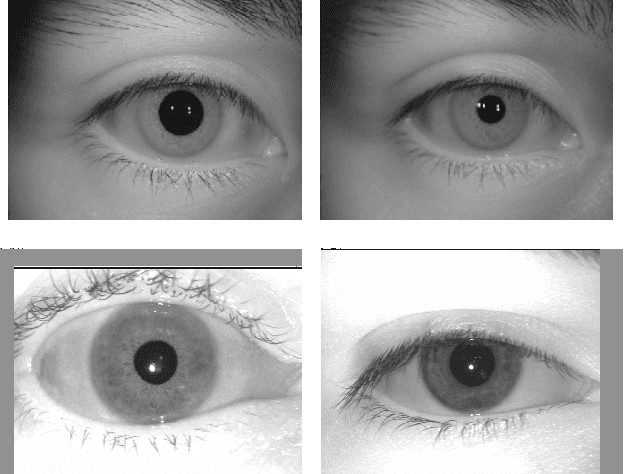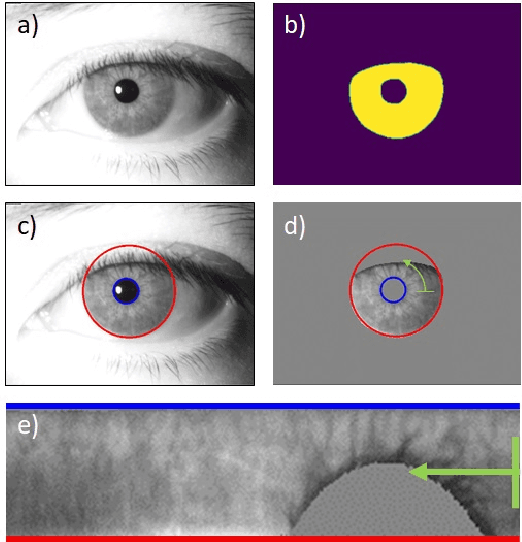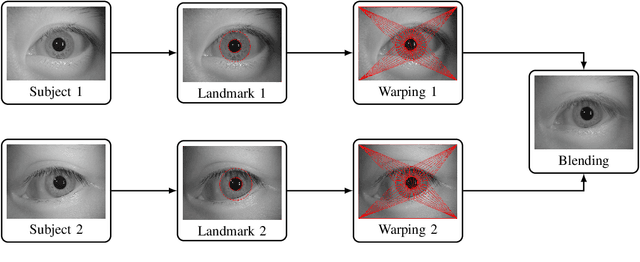Christoph Busch
ChatGPT Encounters Morphing Attack Detection: Zero-Shot MAD with Multi-Modal Large Language Models and General Vision Models
Mar 13, 2025Abstract:Face Recognition Systems (FRS) are increasingly vulnerable to face-morphing attacks, prompting the development of Morphing Attack Detection (MAD) algorithms. However, a key challenge in MAD lies in its limited generalizability to unseen data and its lack of explainability-critical for practical application environments such as enrolment stations and automated border control systems. Recognizing that most existing MAD algorithms rely on supervised learning paradigms, this work explores a novel approach to MAD using zero-shot learning leveraged on Large Language Models (LLMs). We propose two types of zero-shot MAD algorithms: one leveraging general vision models and the other utilizing multimodal LLMs. For general vision models, we address the MAD task by computing the mean support embedding of an independent support set without using morphed images. For the LLM-based approach, we employ the state-of-the-art GPT-4 Turbo API with carefully crafted prompts. To evaluate the feasibility of zero-shot MAD and the effectiveness of the proposed methods, we constructed a print-scan morph dataset featuring various unseen morphing algorithms, simulating challenging real-world application scenarios. Experimental results demonstrated notable detection accuracy, validating the applicability of zero-shot learning for MAD tasks. Additionally, our investigation into LLM-based MAD revealed that multimodal LLMs, such as ChatGPT, exhibit remarkable generalizability to untrained MAD tasks. Furthermore, they possess a unique ability to provide explanations and guidance, which can enhance transparency and usability for end-users in practical applications.
Demographic Variability in Face Image Quality Measures
Jan 14, 2025Abstract:Face image quality assessment (FIQA) algorithms are being integrated into online identity management applications. These applications allow users to upload a face image as part of their document issuance process, where the image is then run through a quality assessment process to make sure it meets the quality and compliance requirements. Concerns about demographic bias have been raised about biometric systems, given the societal implications this may cause. It is therefore important that demographic variability in FIQA algorithms is assessed such that mitigation measures can be created. In this work, we study the demographic variability of all face image quality measures included in the ISO/IEC 29794-5 international standard across three demographic variables: age, gender, and skin tone. The results are rather promising and show no clear bias toward any specific demographic group for most measures. Only two quality measures are found to have considerable variations in their outcomes for different groups on the skin tone variable.
Radial Distortion in Face Images: Detection and Impact
Jan 13, 2025Abstract:Acquiring face images of sufficiently high quality is important for online ID and travel document issuance applications using face recognition systems (FRS). Low-quality, manipulated (intentionally or unintentionally), or distorted images degrade the FRS performance and facilitate documents' misuse. Securing quality for enrolment images, especially in the unsupervised self-enrolment scenario via a smartphone, becomes important to assure FRS performance. In this work, we focus on the less studied area of radial distortion (a.k.a., the fish-eye effect) in face images and its impact on FRS performance. We introduce an effective radial distortion detection model that can detect and flag radial distortion in the enrolment scenario. We formalize the detection model as a face image quality assessment (FIQA) algorithm and provide a careful inspection of the effect of radial distortion on FRS performance. Evaluation results show excellent detection results for the proposed models, and the study on the impact on FRS uncovers valuable insights into how to best use these models in operational systems.
FaceOracle: Chat with a Face Image Oracle
Jan 13, 2025Abstract:A face image is a mandatory part of ID and travel documents. Obtaining high-quality face images when issuing such documents is crucial for both human examiners and automated face recognition systems. In several international standards, face image quality requirements are intricate and defined in detail. Identifying and understanding non-compliance or defects in the submitted face images is crucial for both issuing authorities and applicants. In this work, we introduce FaceOracle, an LLM-powered AI assistant that helps its users analyze a face image in a natural conversational manner using standard compliant algorithms. Leveraging the power of LLMs, users can get explanations of various face image quality concepts as well as interpret the outcome of face image quality assessment (FIQA) algorithms. We implement a proof-of-concept that demonstrates how experts at an issuing authority could integrate FaceOracle into their workflow to analyze, understand, and communicate their decisions more efficiently, resulting in enhanced productivity.
Eye Sclera for Fair Face Image Quality Assessment
Jan 13, 2025Abstract:Fair operational systems are crucial in gaining and maintaining society's trust in face recognition systems (FRS). FRS start with capturing an image and assessing its quality before using it further for enrollment or verification. Fair Face Image Quality Assessment (FIQA) schemes therefore become equally important in the context of fair FRS. This work examines the sclera as a quality assessment region for obtaining a fair FIQA. The sclera region is agnostic to demographic variations and skin colour for assessing the quality of a face image. We analyze three skin tone related ISO/IEC face image quality assessment measures and assess the sclera region as an alternative area for assessing FIQ. Our analysis of the face dataset of individuals from different demographic groups representing different skin tones indicates sclera as an alternative to measure dynamic range, over- and under-exposure of face using sclera region alone. The sclera region being agnostic to skin tone, i.e., demographic factors, provides equal utility as a fair FIQA as shown by our Error-vs-Discard Characteristic (EDC) curve analysis.
Towards Iris Presentation Attack Detection with Foundation Models
Jan 10, 2025



Abstract:Foundation models are becoming increasingly popular due to their strong generalization capabilities resulting from being trained on huge datasets. These generalization capabilities are attractive in areas such as NIR Iris Presentation Attack Detection (PAD), in which databases are limited in the number of subjects and diversity of attack instruments, and there is no correspondence between the bona fide and attack images because, most of the time, they do not belong to the same subjects. This work explores an iris PAD approach based on two foundation models, DinoV2 and VisualOpenClip. The results show that fine-tuning prediction with a small neural network as head overpasses the state-of-the-art performance based on deep learning approaches. However, systems trained from scratch have still reached better results if bona fide and attack images are available.
LADIMO: Face Morph Generation through Biometric Template Inversion with Latent Diffusion
Oct 10, 2024



Abstract:Face morphing attacks pose a severe security threat to face recognition systems, enabling the morphed face image to be verified against multiple identities. To detect such manipulated images, the development of new face morphing methods becomes essential to increase the diversity of training datasets used for face morph detection. In this study, we present a representation-level face morphing approach, namely LADIMO, that performs morphing on two face recognition embeddings. Specifically, we train a Latent Diffusion Model to invert a biometric template - thus reconstructing the face image from an FRS latent representation. Our subsequent vulnerability analysis demonstrates the high morph attack potential in comparison to MIPGAN-II, an established GAN-based face morphing approach. Finally, we exploit the stochastic LADMIO model design in combination with our identity conditioning mechanism to create unlimited morphing attacks from a single face morph image pair. We show that each face morph variant has an individual attack success rate, enabling us to maximize the morph attack potential by applying a simple re-sampling strategy. Code and pre-trained models available here: https://github.com/dasec/LADIMO
SynMorph: Generating Synthetic Face Morphing Dataset with Mated Samples
Sep 09, 2024



Abstract:Face morphing attack detection (MAD) algorithms have become essential to overcome the vulnerability of face recognition systems. To solve the lack of large-scale and public-available datasets due to privacy concerns and restrictions, in this work we propose a new method to generate a synthetic face morphing dataset with 2450 identities and more than 100k morphs. The proposed synthetic face morphing dataset is unique for its high-quality samples, different types of morphing algorithms, and the generalization for both single and differential morphing attack detection algorithms. For experiments, we apply face image quality assessment and vulnerability analysis to evaluate the proposed synthetic face morphing dataset from the perspective of biometric sample quality and morphing attack potential on face recognition systems. The results are benchmarked with an existing SOTA synthetic dataset and a representative non-synthetic and indicate improvement compared with the SOTA. Additionally, we design different protocols and study the applicability of using the proposed synthetic dataset on training morphing attack detection algorithms.
First Competition on Presentation Attack Detection on ID Card
Aug 31, 2024



Abstract:This paper summarises the Competition on Presentation Attack Detection on ID Cards (PAD-IDCard) held at the 2024 International Joint Conference on Biometrics (IJCB2024). The competition attracted a total of ten registered teams, both from academia and industry. In the end, the participating teams submitted five valid submissions, with eight models to be evaluated by the organisers. The competition presented an independent assessment of current state-of-the-art algorithms. Today, no independent evaluation on cross-dataset is available; therefore, this work determined the state-of-the-art on ID cards. To reach this goal, a sequestered test set and baseline algorithms were used to evaluate and compare all the proposals. The sequestered test dataset contains ID cards from four different countries. In summary, a team that chose to be "Anonymous" reached the best average ranking results of 74.80%, followed very closely by the "IDVC" team with 77.65%.
On the Feasibility of Creating Iris Periocular Morphed Images
Aug 24, 2024



Abstract:In the last few years, face morphing has been shown to be a complex challenge for Face Recognition Systems (FRS). Thus, the evaluation of other biometric modalities such as fingerprint, iris, and others must be explored and evaluated to enhance biometric systems. This work proposes an end-to-end framework to produce iris morphs at the image level, creating morphs from Periocular iris images. This framework considers different stages such as pair subject selection, segmentation, morph creation, and a new iris recognition system. In order to create realistic morphed images, two approaches for subject selection are explored: random selection and similar radius size selection. A vulnerability analysis and a Single Morphing Attack Detection algorithm were also explored. The results show that this approach obtained very realistic images that can confuse conventional iris recognition systems.
 Add to Chrome
Add to Chrome Add to Firefox
Add to Firefox Add to Edge
Add to Edge